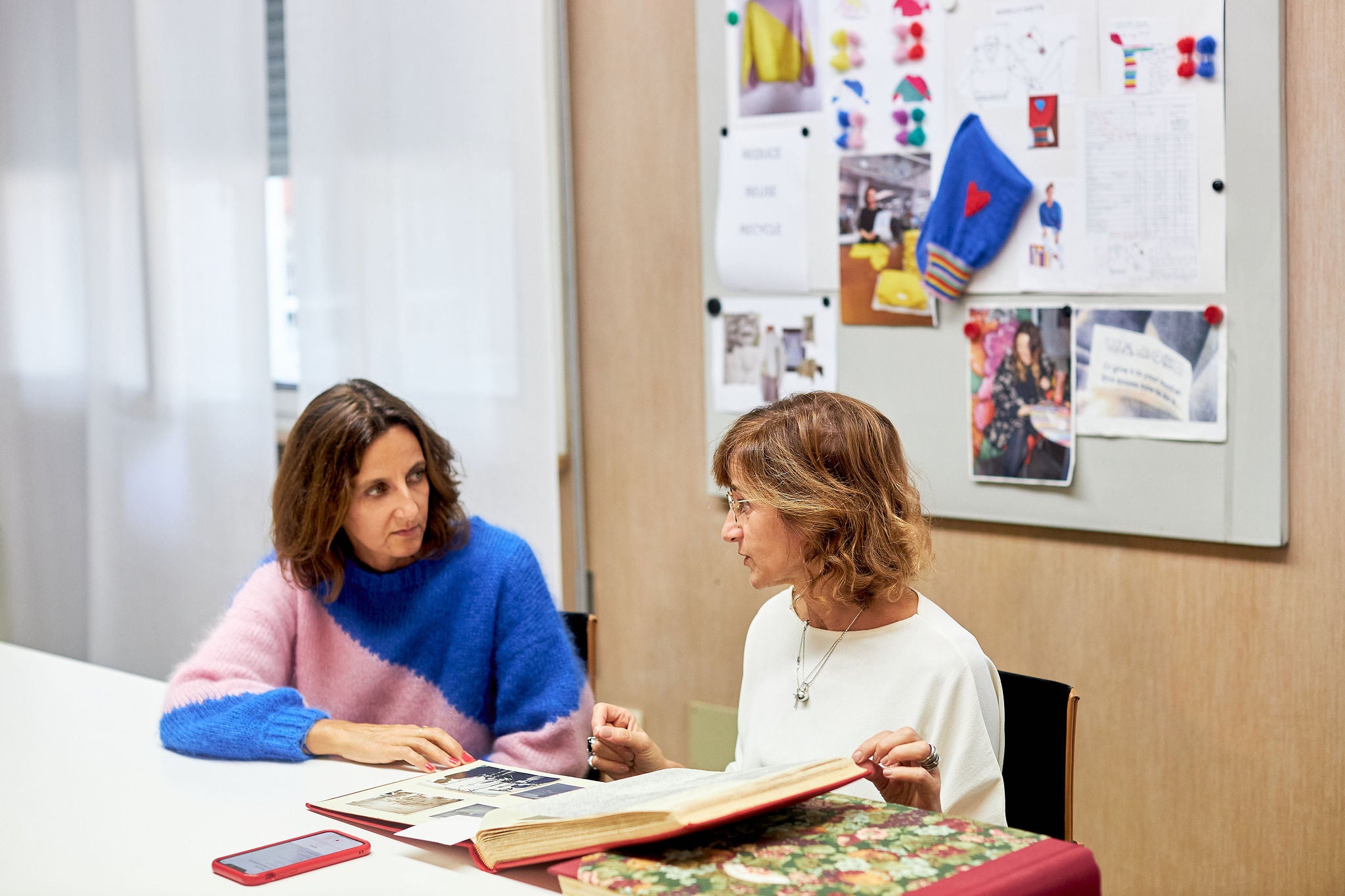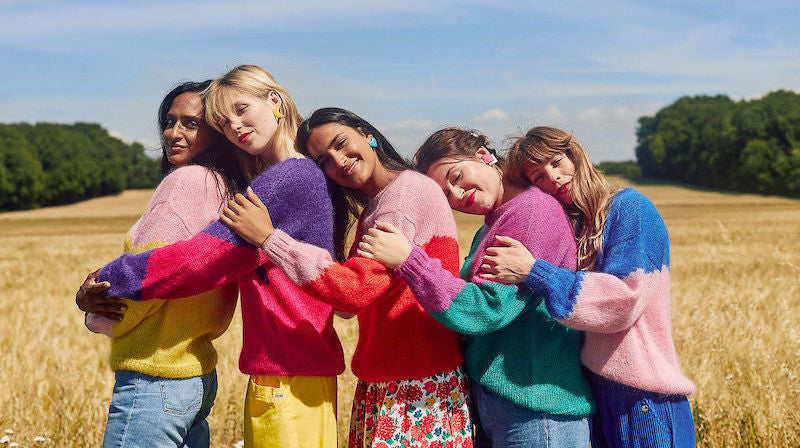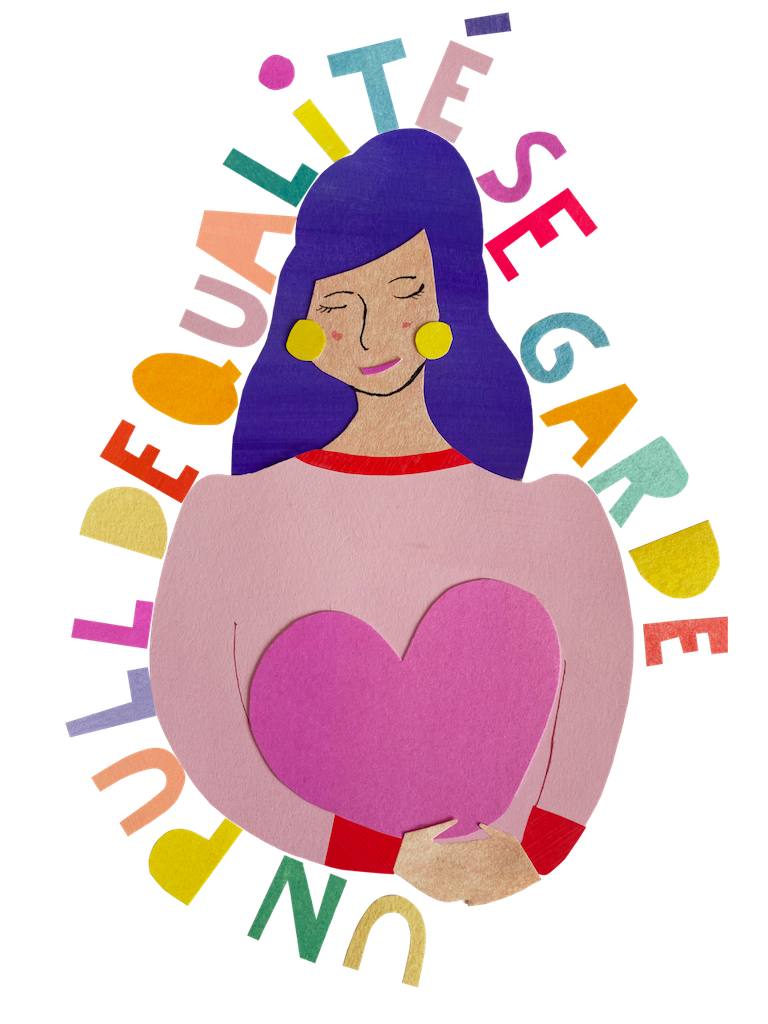"My mother always wanted to do this job, but her family was very poor, so at the age of 10 she had to start working. She asked her father if she could learn the dressmaking trade. Then, at 14, with the money she'd saved, she took her first course. At 18, she met my Dad, who was doing something completely different. Together they set up a small business and bought their first hand-knitting machine. They rented a room in Mirella's mom's house (Mirella is now in charge of supplies). In this room, they worked, but it was also our own home. My brother was born among the machines.

When it was born in 1963, there were already a few employees and 4 machines. In the years 62, 64, 66, knitwear was really coming into its own in Italy. Almost every woman began to have a knitting machine at home to make her own sweaters, and in this region, almost every family had a hand-knitting machine.
Ma Maman began to have important customers, American customers who had an office in Treviso, 20 km from the factory, and had their production done in small workshops. Everything was knitted by machine by hand.
Everything was remeshed. The remeshing machine has remained unchanged since then. It has remained the same.
The big evolution has been in knitting machines. From hand-operated machines, we moved to mechanical machines, but with very long programming systems. Then programming became simpler and the variety of knitting stitches multiplied.

In reality, the duality of our business is that one part, knitting, has undergone enormous evolution with many technological developments, and it's on this that we make ongoing investments, and the other part, garment making, has remained as it is. The remeshing has not changed. The machines we have in the factory are the same today as they were then!
In the face of competition from China, Italy has been looking for time-saving solutions that maintain a well-made garment. For example, we finish the sweater with a knitted chain and then remesh the collar edge. In the past, we used to remesh the 2; it was a double remeshing. The evolution of knitting machines has saved a lot of sewing time, especially on the inner details. On the other hand, the remaining sewing has not changed technically. It's done with the same machines and requires the same know-how as in the old days.
There are also machine-made finishes, but that's not the case with the products we make. There are machines that make dots, for example, but they're not beautiful finishes.So there's a very technological part and a very artisanal part that has remained unchanged.
So to get back to the story, my family has been in the business since 1962. In 1966, when I was born, my father and mother built this small factory. Every 10 years they increased the surface area. The factory was built in 3-4 stages.
We often had people from abroad, especially the Chinese, come to see our factory. The companies selling the machines would ask us to show them how we used the technology. We had very good programmers and were a good reference factory.
We made a lot of Jacquard knits, for example.
We used to have Stoll machines, now we have Shima machines instead. We're considered a fantasy factory.
In 2006, the plant's first female worker retired. She had worked here since 1962!




In 1992, my parents stopped the company, which was called Sapom (Saccon - Antonio - Peruzzetto - Anna Maria).
My brothers and I decided to carry on and created a smaller company: M3 (Marzia Michele and Marco). We decided to work only with client brands and stopped our own collections. We each started with our own skills.
I've always looked after customers and product development. My brother Michele takes care of administration. My brother Marco is in charge of knitting and my sister Reginetta is in charge of production organization.
Mom is always there. Because her life is in the factory. She helps us with hand-finishing, repairing defects and pattern-making. And her experience is always a thousand times greater than ours. Every day I say to myself, "Why don't I know that yet?
For example, when I make changes to models, I still have my doubts, and I know she knows better. My mother worked with a machine by hand, so she learned everything from scratch because that was her job. We studied, but we didn't go through all the phases like she did.

Katia: Is that why you found a machine for your daughter to start with?
Marzia: Yes, because Alice wants to do her diploma subject on our stitch archives, but she's realized that if she doesn't know the in-depth knitting technique, she won't be able to build a well-made archive and sort the swatches. For example, I have a lot of jacquard archives, but to know how to sort them, you need to know how it's done.
K: What's next? You work with long-standing customers...
M: We've had a Belgian customer, NXXXXX , since 1988! Another since 1992. Some more recent customers like FXXXX in Italy. After that, you arrived in 2019. What I like is that all our customers have very different products. Each customer has his own style, colors and yarns. It's good because everything is very differentiated and my head has to fit into different worlds.
For example, when you arrived, it was the right time, because we were starting to talk about sustainability, about a new way of living and working, but perhaps if we hadn't met you, we would have listened without trying to change. Getting to know you has brought us into this more conscious, more responsible world of work, and made us think differently. Today, for example, we're starting a study of our company to see what we can improve and what we've already done well. It's starting with me, my brothers and sisters, and in 2-3 months' time we're going to start talking about it with our colleagues, because we want to go down this road and help the company evolve.
It was a really positive encounter and it did us a lot of good, so I hope it can continue for a long time. If we hadn't met, we might not have taken this turn at the time, and today it's important to have started early. We also realize that we're already doing a lot of things right, because it was ingrained in our lifestyle and our way of working and our family: Don't waste anything.
K: Is it good to feel like you're evolving?
M: Above all, to be stimulated. Even during this very difficult ½ year, we've always had the strength to move forward and look to the future for ourselves, for our workers, for the small factories that work for us. We have quite a few small companies that do outside tailoring, for example, and they're all in the region. These are small family businesses, 2-3 people from the same family who need to work.
We made sure during this ½ year to give everyone a little work, even if it was just a little. Not a lot, but the minimum to survive the crisis. It gives us strength. That's one of the reasons we want to stay small, because it's all about relationships. You have to be able to listen and talk, like I do with you or the other customers.
Yes, we don't earn much but it's the quality of life we have in the factory. We're in the factory 12 hours a day. We, the family, work even on Saturday mornings, so it's a lot of time, and if we don't have good relationships, it's going to become impossible. That's another reason why we want to stay small."
Marzia - September 2021
SOMETHING NEW IN SEPTEMBER 2021...
🎂 The factory turns 60 in September 2022!

Marzia: "2 weeks ago we celebrated 60 years in business and we held an event here at the factory to thank all our internal and external collaborators and all the people who, in these 60 years, have in any way contributed to our path ... I'll send you some photos ... it was a special evening, with many memories but also reflection and hopes for the future ...
For the occasion, we've put together a small photographic exhibition on our history and ethical path, as well as a small parade with archive pieces from the 70s to the present day. In one of the photos attached here you'll see the end of the same parade ... I hope you enjoy it!"
🇮🇪 Higher prices in Venetto! (october 2022)

Marzia: "Indeed, our region is very often considered "expensive" for knitwear production, but it's also true that, unlike other regions such as Prato or Carpi, Veneto has always worked on more upmarket or even luxury products, and has always scrupulously followed fiscal and social regulations. That's why so many high-end labels are produced here in our region, because we have a real history in the more refined, qualitative productions that require research. So, our employees and craftsmen are better paid here in Veneto than elsewhere, but they are our human capital without whom we couldn't do our job, and as a result, some products are more expensive here than elsewhere."
☎️ Costs rising inexorably. (March 2023)

Marzia: Since Covid, we've had to cope with increases in raw materials and electricity costs, but we've also had to cope with an increase in salaries. In fact, many high-end brands or second lines of luxury brands have repatriated their production to our region, known for its high-end products.These labels are prepared to pay any price to get their products; the workshops are raising their prices, the employees are asking for wage increases, but we, on the other hand, have to be very, very careful, and we're within 50 centimes.
In our segment, the quality/price ratio is very tight, so we have to offer a top product, with high-performance yarns that are as durable as possible, with high quality but at the lowest possible price .... Not easy at all.
Sometimes I have the impression that this system is going to crush us, but we don't know how to work less well to go faster, we don't know how to be more "cunning" to earn more, we simply know how to work as seriously as possible, with the maximum of our experience, because this work has always been our life.
🌍 A journey towards even greater environmental responsibility.

Marzia (April 2023): "We've just (this morning) completed our second course in sustainability.
It's not easy, because it requires extra time and work, but we're very happy to have started it and to be continuing.
We've set quite ambitious objectives for the year 2023/24, and we really hope to be able to implement them.
I didn't tell you, but last week I was invited to talk about our experience in a high school, and it was a great experience, because it's the little things we're doing to work towards sustainability, but also to spread this awareness, inside and outside our little factory.
So thank you again for choosing us as a Partner for your eco-responsible brand; you should know that I often refer to you as the "first person responsible" for our own choice in eco-responsibility!
K: Can you tell us more about your short-term objectives?
Marzia (May 2023): I'll try to explain what we've done so far and our short-term goals.
Over the last 2 years we've studied sustainability and its various aspects in some depth, both in general to acquire and deepen our knowledge and in direct relation to our situation at the factory. We have managed to draw up our own sustainability report, which will soon be available on request.
In the meantime, we have begun to take action to improve our level of sustainability, conscious of the fact that, as a small company, we have to proceed in small steps.
Our current, and main, focuses are social sustainability, energy efficiency and attention to the use of raw materials that are as eco-responsible as possible. In particular, we are in the process of increasing our consumption of electricity from renewable sources, and at the same time we are looking into the possibility of investing in photovoltaic panels. We are also encouraging all our employees to save energy resources and to differentiate waste processing so that natural fibers can be fully recycled.
Thank you for stopping by! I'm delighted that you know more about Marzia's factory.



